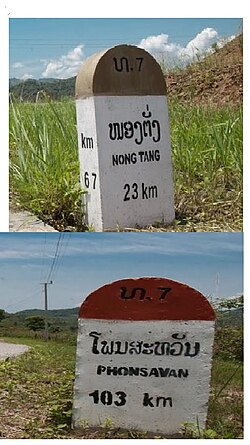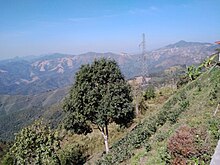Route 7 (Laos)
This article needs additional citations for verification. (July 2022) |
Laos Route 7 (ເສັ້ນ ທາງ ເລກ 7 ຂອງ ປະເທດລາວ) | |
|---|---|
 Route 7 of Laos country (ເສັ້ນ ທ. 7 ຂອງປະເທດລາວ) | |
| Country | Laos |
| Province | Xiangkhouang |
| Length_km | 250 |
| Terminus_3 | Nong Het |
| Terminus_4 | Phou Khoun |
Route 7[1][2][3][4][5] [6][7] [8][9][10][11][12][13] of Laos, ເສັ້ນ ທາງ ເລກ 7[14][15] ຂອງປະເທດລາວ (ທ. 7)[16][17][18][19] is a provincial road served from east to west in Xiangkhouang province, Laos. It runs from Nong Het[20][21] in the east to Phoukhoune District[22][23] in the west. This is where people change connections to go to Luang Prabang or Vientiane.[24]
History
[edit]Route 7 (Laos)[25] is built in the early 1905 by a Resident, Mr. Sestier. It started from Vinh to Cua-rao, Vietnam, then to Muong-sen and Tran-Ninh, the former capital of Xieng khouang at the time, in XiangKhouang province, Laos, for a distance of 402 kilometers. During construction, a credit of 300,000 piastres was granted by Mr. Beau, one of the Governor Generals of Indochina at the time. Subsequently, the road was abandoned due to costly maintenance and upkeep.[26]
Afterwards, in 1911, it was taken over by a vigorous administrator-creator, Mr. Barthelemy, government commissioner of the Laotian province of Tran-Ninh (Xiangkhouang Plateau), XiangKhouang Province. It was undertaken following the trip that MR. Albert Sarraut, Governor General of Indochina, made Tran-Ninh in 1911. History of this route 7, especially at that time, the part before Cua-rao which is located in Vietnam bears the name of Mr. Sestier. Then the other after Cua-rao bears the name of MR. Barthelemy, the current Xiengkhouang Government Commissioner at that time.[27] This was the period that the French controlled the former Lao Kingdom Lan Xang.[28]
Nong Het is the first city in Laos where Route 7 is passing, especially in the northeast. This city is only a few kilometers from the border of the two countries, Laos and Vietnam. From 1916, it was extended to Muong-sen and Ban Bane,[29] two neighboring villages located on the Route 7[30] near Muang Kham, Laos. Then, it went to expand to Ban Khang Khai,[31] a village located northeast of Phonsavan, then to Phonsavan, the Plain of Jars and Muang Soui thereafter. Construction of Route 7 is completed in March 1923 at the same time with those Routes 8 and 9 which are located in the central and southern of Laos.
For the part which is from Muang Soui/Nongtang to Phoukhoune District[32] the construction was French-built at the beginning of the 1940s. Route 7[33] serves actually cities of Nong Het, Muang Kham, Laos, Phonsavan, Muang Soui/Nongtang, and then Phoukhoune District. The total distance from Nong Het to Phoukhoune District (Sala Phou Khoun)[34] is approximately 249.9 kilometers.

Intersections
[edit]
Whether before or now, Route 7 is the direct access between Laos and Vietnam, especially in northeastern Laos. The city of Nong Het[35] was founded a little over a century ago. It is only a few kilometers from the Vietnamese border. It was a city where there were many Hmong/Miao people lived there in the past, especially before the Vietnam War. Driving from Nong Het to Muang Kham, Laos, the distance is about 64.4 km.
Muang Kham, Laos (ເມືອງຄຳ)
[edit]Muang Kham[36] is a small town located northeast of Phonsavan about 55.1 km. On the Route 7 coming from Phonsavan to north and east, about 18 km from Muang Kham, there are two hot mineral springs.[37] The larger one has been developed as a resort with bungalows and bathing facilities. Both are located less than a mile from Route 7. In downtown of Muang Kham, Route 7 runs through the middle of town and heads straight to Nong Het. To go to Samneua or Houaphanh province, intersection of Route 1C is on the left in downtown.

The intersection of Route 7 (Laos)[39][40] and the other ones that go to south, especially to Muang Thuang, Muang Khoun, and passing through Paksan, etc. is located in Phonsavan downtown.[41] Phonsavan is the capital of Xiangkhouang province. It is the city from which the US had dropped thousands of bombs during the Vietnam War of 1961-1975. The Plain of Jars, a UNESCO World Heritage Site, is located less than 13 km from Phonsavan downtown.
Muang Soui /Nongtang (ເມືອງສຸຍ Moos Xoy
[edit]Muang Soui[42] was the name of the town until the end of 1975. After the Vietnam War, Muang soui reverted to Nong Tang as it was before. This city of Muang Soui which is Nong Tang today is located in between the east and the west which are Nong Het and Luang prabang. The distance between Muang Soui and Phonsavan is about 47.2 km to the east, and 89.4 km to Phoukhoune which is west.
Phoukhoune District (ເມືອງພູຄູນ Roob Phuv Khoo
[edit]

Phoukhoune or Phou Khoun[43] is a small town located on the top of the mountain called Phoukhoune or Phou Khoun. It lies northeast of Vang Vieng and west of Muang Soui and Ban Phou Pheung Noi. Route 7 is built over the mountains and valleys from then Muang Soui.
Arrived at Phoukhoune, there is an intersection of Route 13 with Route 7[44][45] This is the connection comes from Vang vieng to go to Luang prabang. Some people call the city of three way stops coming from Vang vieng, Luang prabang, and Phonsavan. This refers in particular for travelers who wish to change connections to go to Luang prabang, Phonsavan, or Vang vieng. Phoukhoune District is 99.4 km from Vang Vieng, and 127.9 km from Luang Prabang.
See also
[edit]- Ban Phou Pheung Noi
- Muang Soui
- Sam Thong
- Hmong New Year
- Tchao Anouvong cave
- Anouvong district
- Kuang Si Falls
- Luang Prabang Night Market
References
[edit]- ^ Elisabeth Eaves (July 13, 2012). "In Laos, the Lady and the Jars-see first page-second paragraph-That year, an archaeologist named Madeleine Colani took refuge at the road works encampment there". The New York Times.
- ^ By Malcolm W. Browne Special to The New York Times (January 22, 1973). "Villagers Worrying About a Postwar Laos-see-paragraph-that-starts-from-Communist units overran Sala Phou Khoun, an important Government mountain base at the intersection of Routes 13 and 7". The New York Times.
- ^ "Route 7-see citation on page#29-30 of 62" (PDF).
- ^ Webb, Billy G. (June 10, 2016). Route 7. Xlibris Corporation. ISBN 9781514486856.
- ^ "Eaves, Elisabeth. "In Laos, the lady and the jars." New York Times, 15 July 2012, p. 8(L). Gale Academic OneFile, link.gale.com/apps/doc/A296399728/AONE?u=anon~24f5eea7&sid=googleScholar&xid=2421d9cc. Accessed 25 Oct. 2022".
- ^ "National Route No. 7_see citation on page#7 of 13" (PDF).
- ^ "Route _ Minutes of a Meeting, White House_on paragraph#2_Souvanna Phouma's request for interdiction operations along Route 7". Office of Historian.
- ^ "Route 7_cited on 3rd paragraph_Souvanna Phouma and other Lao leaders.... if Muong Soui falls". Office of the Historian.
- ^ Angela Renee Dickey. "The U.S. Media and the "Secret" War in Laos, 1955-1975" (PDF).
Routes 6 and 7 from Plain of Jars_on page 82_in second paragraph
- ^ Division, Naval Intelligence (January 11, 2013). Route Coloniale no 7-cited on pages 414-416. Routledge. ISBN 9781136209185.
- ^ "Route No 7". 1961.
- ^ Guides, Rough (September 3, 2012). Route_7_of_Laos. Rough Guides. ISBN 9781409360582.
- ^ "Route_No_7_Laos". 1964.
- ^ "ເສັ້ນທາງເລກ 7 ຊຽງຂວາງ_Route 7(Laos)" (in Latin).
- ^ "ເອກະສານຮອ້ ງຂກໍ ານຊວ່ ຍເຫ ຼືອໂຄງການ ເສມີສາ້ງຄວາມໝນ ້ຄງົຂອງມະນດ ຸ ໃນຂນ ້ຮາກຖານ_Route 7 citation on paragraph #10 10.ເຂດທ່ີນອກເປົ້າໝາຍ ・ເຂດພິເສດໄຊສມົບນູ (ໃນປະຈບຸ ນ ແມນ່ ເມອຼືງໄຊສມົບູນ ແຂວງວຽງຈນ ແລະ ເມອຼືງທາ່ ໂທມ ແຂວງຊຽງຂວາງ) ・ເມອຼືງຄູນ ແຂວງຊຽງຂວາງ ແລະ ບໍລິເວນເມອຼືງຄນູ (ແຕເ່ ສ ້ນທາງເລກ 5 ຫາ ທາງໄປເມອຼືງໂພນສະຫວນ ) ・ແຕເ່ ມອຼືງພຄູ ນູ ແຂວງຫ ວງພະບາງ (ເສ ້ນທາງເລກ 7) ຫາ ເມອຼືງໂພນສະຫວນ ແຂວງຊຽງຂວາງ (ນອກຈາກຕວົເມອຼືງໂພນສະຫວນ ) ແລະ ເມອຼືງຊາໍເໜຼືອ ແຂວງຫວົພນ (ນອກຈາກຕວົເມອຼືງຊາໍເໜຼືອ)" (PDF) (in Latin).
- ^ "Route 7". October 30, 2010.
- ^ "Route 7 from Vang vieng to Vietnam".
- ^ "The War in Northern Laos, 1954-1973, Route 7 cited on each 2nd paragraph of pages 170, p-203, and p-206" (PDF).
- ^ "Phou Khout_Route 7 cited on paragraph " Found off of Route 7, Phou Khout (also Kood, Kout) is an interesting and remote side adventure 43 kilometres from Phonsavan. The district can be combined with Muang Soui (Nong Tang) for a long day trip from the city, and more on the same page".
- ^ Frederic C. Benson (January 2015). "Nong Het". Hmong Studies Journal. 16: #02 of 62, Introduction_pragraph #03. Retrieved May 6, 2022.
- ^ Billy G. Webb (September 13, 2010). Secret War, Route 7. Xlibris Corporation. ISBN 9781453564868.
- ^ Billy G. Webb (September 13, 2010). Secret War - Page 419, Routes 7 and 13 junction at Phou Khoun. Xlibris Corporation. ISBN 9781453564868.
- ^ Benson, Frederic (January 2021). "Turbulence in Sam Neua Province (Laos): 1953-1970_in paragraph of_The_Strategic_Location_of_the_Plain_of_Jars in page #28 & 29 starting: The most significant feature of northeastern Laos...the Mekong River across from Thailand (Blaufarb 1977: 130)". This paper was originally published as two chapters in 2018 by Radix Press in "Indochina in the Year of the Dog, 1970" and "Indochina in the Year of the Pig, 1971", respectively. Attached is an unpublished 2021 revision.
- ^ "Route 7 is cited in section of Northern Laos". February 4, 2014.
- ^ Dommen, Arthur J. (September 17, 2019). Route 7. Routledge. ISBN 9780429725807.
- ^ Jean Brunhes (1923). "Les routes nouvelles de l'Annam au Laos_page #429_3rd paragraph starting from "Pareillement est route automobilable...le capitaine Thierry"". Annales de géographie (in French). 32 (179): 426–450. doi:10.3406/geo.1923.9798.
- ^ Jean Brunhes (1923). "Annales de geographie_page #430_3rd paragraph starting from "La nouvelle route du Tran-Ninh...(abri pour les voyageurs)"". Annales de géographie (in French). 32 (179): 426–450. doi:10.3406/geo.1923.9798.
- ^ Stuart-Fox, Martin (1995). "The French in Laos, 1887-1945". Modern Asian Studies. 29 (1): 111–139. doi:10.1017/S0026749X00012646. JSTOR 312913. S2CID 146208659.
- ^ E. H. S. Simmonds. "The Problem of Laos, Route 7 is cited on the 3rd line at the end". JSTOR 40394377.
- ^ "Route 7". 1964.
- ^ "Ban Khang Khai".
- ^ Jeff Cranmer, steven Martin (2002). Muang Soui on the Route 7 to Phoukhoune District. Rough Guides. ISBN 9781858289052.
- ^ "Pro-reds in Laos Reported Halted in Drive On Base; Strafing by Government's Bombers Is Said to Stall Advance of Pathet Lao/date=1964-18-07_about Route 7 citation is on paragraph "Muong Soui blocks the Pathet Lao advance westward along Route 7 to its junction with Route 13, which runs south to Vientiane, the administrative capital, and north to Luang Prabang, the Royal capital"". The New York Times. July 18, 1964.
- ^ "Route 7 and Route 13 junction".
- ^ "M. Nong Het".
- ^ "Muang Kham, Laos".
- ^ "Hot springs on Route 7".
- ^ "mini-guide-phonsavan".
- ^ Guides, Rough (September 19, 2017). Route 7. Penguin. ISBN 9780241326206.
- ^ Atiyah, Jeremy (2002). Phonsavan_Route 7. Rough Guides. ISBN 978-1-85828-893-2.
- ^ "Route 7 maps in Phonsavan".
- ^ "Muang Soui or Muang Soy".
- ^ "Phoukhoune or Phou Khoun".
- ^ Benson, Frederic (January 2021). "Turbulence in Sam Neua Province (Laos): 1953-1970_in paragraph of_The_Strategic_Location_of_the_Plain_of_Jars in page #28 & 29 starting: The most significant feature of northeastern Laos...the Mekong River across from Thailand (Blaufarb 1977: 130)". This paper was originally published as two chapters in 2018 by Radix Press in "Indochina in the Year of the Dog, 1970" and "Indochina in the Year of the Pig, 1971", respectively. Attached is an unpublished 2021 revision.
- ^ "The Perfect Northern Laos Itinerary: What to See & How to See it!_Route 7 citing in paragraph "After decades of civil unrest and political insurgences, Routes 7 and 13 are finally regarded as safe. Still, it is worth checking travel advisories or asking around in Luang Prabang or Vientiane for the current situation to ensure it's still safe prior to travelling these routes"". June 6, 2019.
This article needs additional or more specific categories. (June 2022) |


 French
French Deutsch
Deutsch